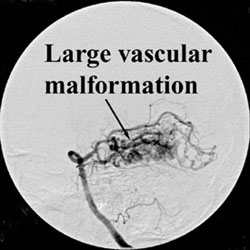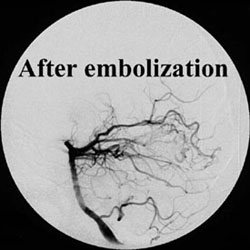Glue Embolization
It is sometimes necessary to permanently occlude a major artery (such as the carotid artery on one side) in order to treat an abnormality of the blood vessels or in order for the surgeon to remove a tumor that has grown around the artery. If this is necessary, a test is performed (temporary test occlusion) to make sure that it is safe to block off this artery (most people can tolerate having one carotid artery blocked off). For this test, a catheter is placed into an artery (usually in the leg, like for an angiogram of the heart) and a catheter with a small balloon on the tip is threaded through this into the artery of interest. The balloon is inflated, stopping the blood flow in that artery. Neurological tests are performed every few minutes to see if there are symptoms. If there are none, the artery can be permanently occluded. This may be done in a similar way. A catheter is threaded up into the artery and material is injected to block off the flow. The type of material used depends on which artery is being occluded and on the particular circumstance.


Back to list of procedures